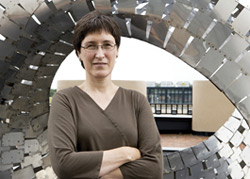Essay: Anne Mary Teichert
 |
| Photo: Cindy Arnold, Fermilab |
For Fermilab visitors, a sense of wonder
People visit Fermilab for many reasons. For those with an interest in physics or engineering, the draw, of course, is the chance to see Fermilab’s equipment up close and the opportunity to sample life at a great laboratory. It’s not surprising that the lab’s countless visitors are excited by what they see and impressed by the working environment.
Many visitors come with only a vague sense of what goes on at the laboratory. “It’s an atom smasher, right?” they sometimes ask before a tour. And some have no idea why Fermilab exists. Maybe they are here to accompany a spouse or child, or perhaps they saw Fermilab listed under “Things to see near Chicago.” What’s interesting to us, as docents, is what a strong first impression the lab makes on its visitors.
Before officially touring the site, visitors have already encountered the beautiful natural environment and architecture of the site. They have driven through woods and tallgrass prairie to reach the main building with its light-filled atrium. Often the first comment we hear is something like, “Gee, I didn’t think a physics lab would look so nice.”
The setting and architecture at Fermilab may inspire admiration, but learning about the science inspires amazement.
Visitors hear about trillions of particles traveling at unimaginable speeds, colliding millions of times a second, producing ephemeral matter that hasn’t existed since the big bang. They hear that antimatter is real, that torrents of neutrinos stream unnoticed through their bodies, and that the atoms they are made of are more empty than solid. By the time they learn that all the matter we know about constitutes less than five percent of the universe, heads are shaking and wonder is apparent on peoples’ faces.
For some visitors, meeting a scientist is a revelation. School children are often amazed to learn that scientists don’t have Einstein-ish hair and that they lead normal social lives. Other guests tell us that they are surprised by physicists’ eagerness to communicate, regardless of an audience’s lack of technical background. Some mention that what struck them most during their visit was the excitement they sensed in the scientists about the work they do.
Sometimes a visit resonates long after the tour is over. High school students tell us, “I never liked science and I thought this field trip would be boring, but this stuff is awesome!” Parents who come as chaperones ask for book lists so that they can learn more. Visitors with an initial casual interest return to Fermilab again and again as that interest grows into a passion. High school students apply for summer internships or enroll in Saturday Morning Physics classes. We’ve even heard of college students switching majors after field trips to the lab.
Fermilab sponsors a monthly program called Ask-A-Scientist that includes a presentation about the lab’s research, a lab tour, and an opportunity to chat with scientists. Parents occasionally bring scientifically precocious youngsters to these sessions, hoping that physicists will be able to answer questions that Mom and Dad can’t. Scientists are happy to talk with these bright kids, and often encourage them to interact with one another so that they can find friends who share the same curiosity and excitement about physics.
I suspect that the juxtaposition of the ordinary and the extraordinary at Fermilab only adds to the effect that it has on visitors. As coyotes sniff for prey in the fields, matter and antimatter annihilate over and over and equations scribbled on blackboards reveal startling insights about space and time.
It’s interesting to us docents to see how strongly visitors respond to the laboratory. But, frankly, we aren’t surprised. Day after day, as we drive to work through the prairie and past the beam lines, we feel the same wonder and appreciation. We know that we are fortunate to be part of this place.
Anne Mary Teichert
Anne Mary Teichert stumbled on an interest in particle physics while studying art. She and 20 other docents lead tours for school groups and other visitors at Fermilab.
Click here to download the pdf version of this article.


